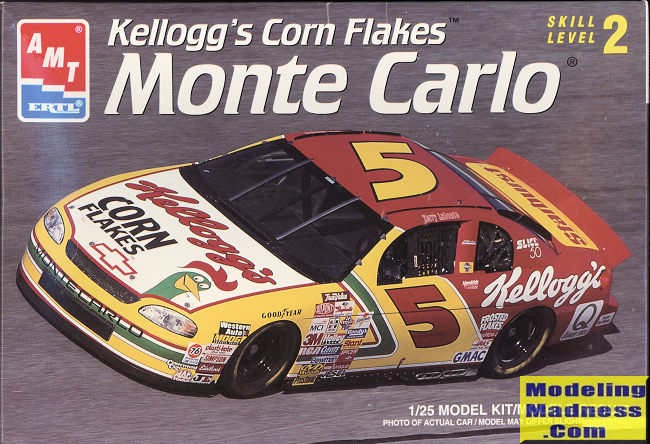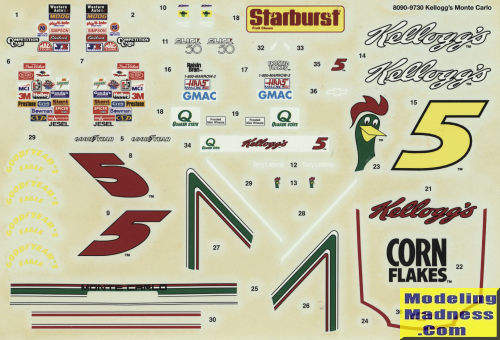AMT 1/25 Kellog's Corn Flakes Monte Carlo
|
KIT #: |
8090 |
|
PRICE: |
Raffle win |
|
DECALS: |
One option |
|
REVIEWER: |
Scott Van Aken |
|
NOTES: |
1997 release |

After leaving his previous team in 1993, Terry Labonte
was signed to Hendrick Motorsports in 1994, where he began driving the No.
5 Kellogg's-sponsored Chevrolet Lumina. In 1995, the team switched
to Chevrolet Monte Carlos and won three races including the fall Goody's 500
event at Bristol, where the front of Labonte's car was wrecked after Dale
Earnhardt crashed into him in the final lap. In 1996, he broke Richard
Petty’s streak for consecutive races after winning at North Wilkesboro.
Despite only two victories, Labonte went on to win the championship, a
record-setting twelve years after his first. Driving with a broken hand
during the last two races of the season, Labonte and his younger
brother Bobby were able to perform a dual victory lap at Atlanta Motor
Speedway in the last race of the season; Bobby won the race and Terry won
the championship on this race, making it the only time a driver and his
sibling won the race and the championship at the same time.
In the heady days of NASCAR model kits, both AMT and Monogram were cranking
them out as fast as they could make them. Today, modelers with these kits
can barely give them away, hence this one being donated to a raffle where I
got it. There is really little that is different between the AMT and
Monogram offerings as they are all based pretty much on the same chassis.
The only difference is the body and decals.
Generally speaking, AMT has molded all their NASCAR kits in a medium grey
plastic. Detailing on the parts is good though some thing Monogram's is
crisper. Instructions have you building up the engine, then the tires (note
that the front wheels take stub axles while the rear takes a metal one. Then
the interior is assembled along with the engine and radiator. This is
followed by the interior roll cage and some of the framework around the
engine. I would recommend test fitting to see if you can install the engine
after painting the forward framework.
Next the undercarriage pieces are glued in place and this is the time to see
if all the wheels touch the ground so it might be useful to do this before
all the suspension bits are dry in case some sort of adjustment is needed.
It is only the final step where the body is dealt with. All the clear bits
can be added from the outside which makes it easier to paint the body prior
to attaching the decals.
 Instructions
are well done and offer generic color information. As with most car kits,
parts need to be painted prior to attaching them. The livery is for one car
in red and yellow. The red, white, and yellow parts will need to be painted,
but it is a fairly easy masking scheme. There are a nice side of placement
drawings included and you can easily find images of the car on the 'net. I'm
thinking this is Terry's 1996 car. The large decal sheet is nicely printed
and a bit on the thick side. I've found that these old sheets are generally
still viable if in good condition as aftermarket sheets are generally fairly
difficult to find since the lawyers want fees from every sponsor that has
their name or sticker on the side of the car.
Instructions
are well done and offer generic color information. As with most car kits,
parts need to be painted prior to attaching them. The livery is for one car
in red and yellow. The red, white, and yellow parts will need to be painted,
but it is a fairly easy masking scheme. There are a nice side of placement
drawings included and you can easily find images of the car on the 'net. I'm
thinking this is Terry's 1996 car. The large decal sheet is nicely printed
and a bit on the thick side. I've found that these old sheets are generally
still viable if in good condition as aftermarket sheets are generally fairly
difficult to find since the lawyers want fees from every sponsor that has
their name or sticker on the side of the car.
So, NASCAR stockers are out of favor. Bit of a shame, but there it is. These
kits build well, look nice on the shelf and can generally be picked up at
shows for very little money. If you like racing cars and have never tried
one of these, give it a go. I think you'll be pleased with the results.
https://en.wikipedia.org/wiki/Terry_Labonte
October 2021
Copyright ModelingMadness.com. All rights reserved. No
reproduction in part or in whole without express permission.
If you would like your product reviewed fairly and fairly quickly, please
contact the editor or see other details in the
Note to
Contributors.
Back to the Main Page
Back to the Review Index Page
Back to the Previews Index Page


 Instructions
are well done and offer generic color information. As with most car kits,
parts need to be painted prior to attaching them. The livery is for one car
in red and yellow. The red, white, and yellow parts will need to be painted,
but it is a fairly easy masking scheme. There are a nice side of placement
drawings included and you can easily find images of the car on the 'net. I'm
thinking this is Terry's 1996 car. The large decal sheet is nicely printed
and a bit on the thick side. I've found that these old sheets are generally
still viable if in good condition as aftermarket sheets are generally fairly
difficult to find since the lawyers want fees from every sponsor that has
their name or sticker on the side of the car.
Instructions
are well done and offer generic color information. As with most car kits,
parts need to be painted prior to attaching them. The livery is for one car
in red and yellow. The red, white, and yellow parts will need to be painted,
but it is a fairly easy masking scheme. There are a nice side of placement
drawings included and you can easily find images of the car on the 'net. I'm
thinking this is Terry's 1996 car. The large decal sheet is nicely printed
and a bit on the thick side. I've found that these old sheets are generally
still viable if in good condition as aftermarket sheets are generally fairly
difficult to find since the lawyers want fees from every sponsor that has
their name or sticker on the side of the car.